Words Justin Croft Photographs Justin Croft
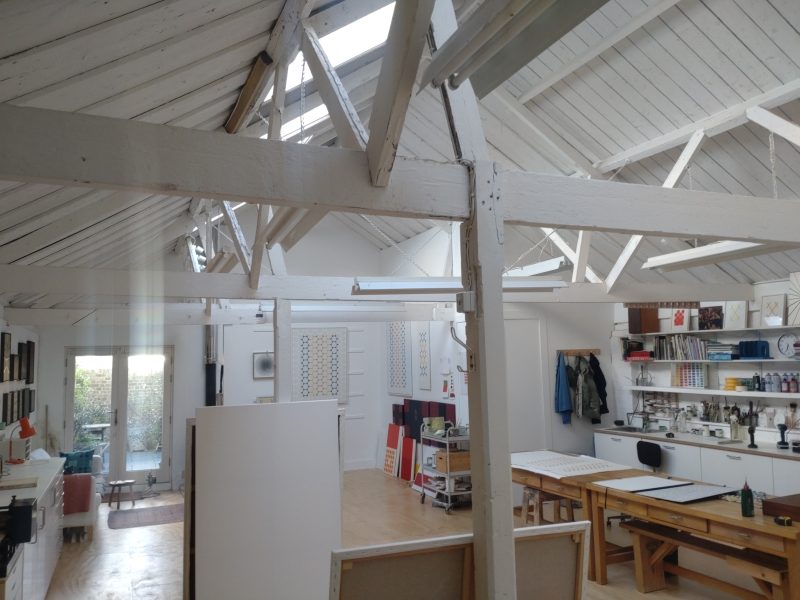
Late afternoon light in Guy Rutter’s Faversham studio
As the sky filled with darkening clouds outside, we found ourselves stepping into a luminous and voluminous space where the fading light seemed magnified and intensified by generous skylights and the pervading whiteness of the studio interior. Over the past decade, Guy has transformed the space from its former life as a car mechanic’s garage.
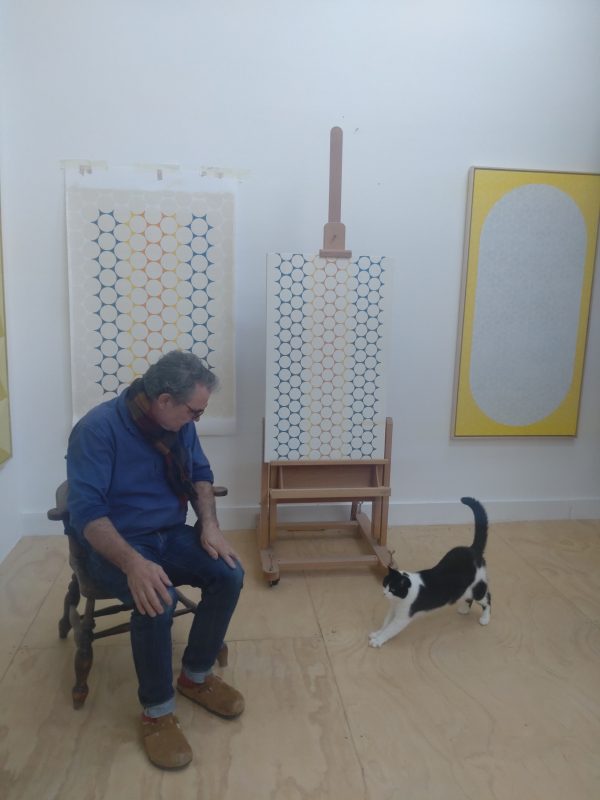
Guy Rutter with Henry the cat
Brought up near Faversham, with forays further afield for art school in Falmouth in the 1980s, and training as a theatrical painter at London’s Guildhall School of Music and Drama (Barbican) Guy has made the town his home for many years.
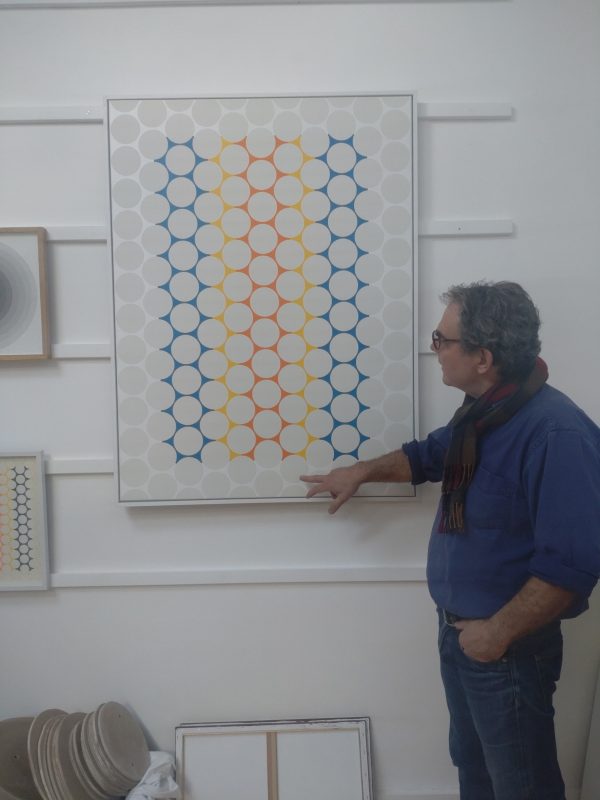
Guy Rutter and Sennen
The studio is large and readily accommodates even the larger pieces that Guy has created over the years. His style is immediately recognisable ― bold geometrical patterns in striking colours, often with repeated forms across large canvasses. Some of these exist in multiple versions, creating a series with variations of scale, tone and detail. The most recent project is a series of large oils on canvas called ‘Sennen’. Of course, we’re curious about the title, and how a famous Cornish cove finds its way into a work which is pure geometric abstraction. Guy explains, and it’s all about colour and atmosphere.
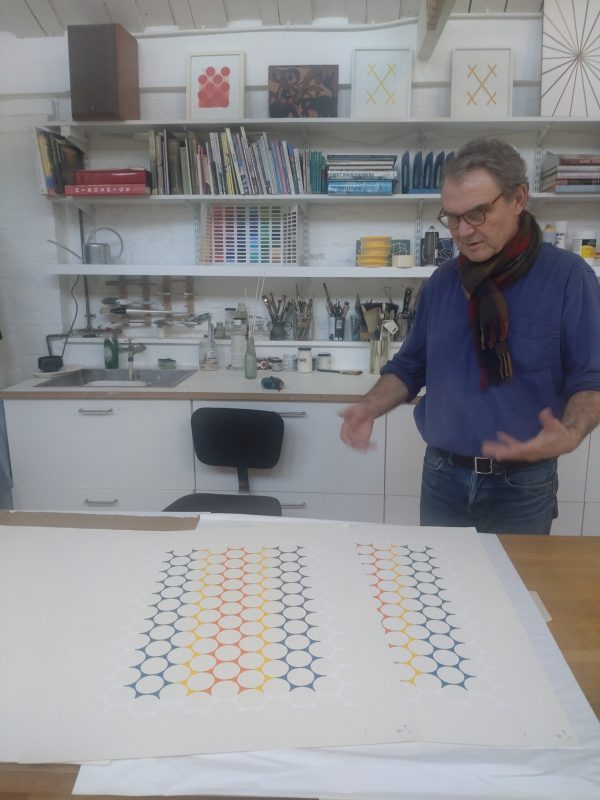
Limited edition screenprints of Sennen, made in collaboration with Sarah Simmonds at Goose Studio (Creek Creative).
We might expect a moody, gauzy seascape from such a title, but what he sees are not just the tones of sky, sand and water but the explosions of pure colour in the towels, t-shirts and swimming costumes of summer visitors on the beach. Both Cornwall and colour are strands which run deep in his art, and Guy readily admits influences from the St Ives painters of the 20th century, and artists like Patrick Heron, with whom he came into direct contact when studying in Cornwall.
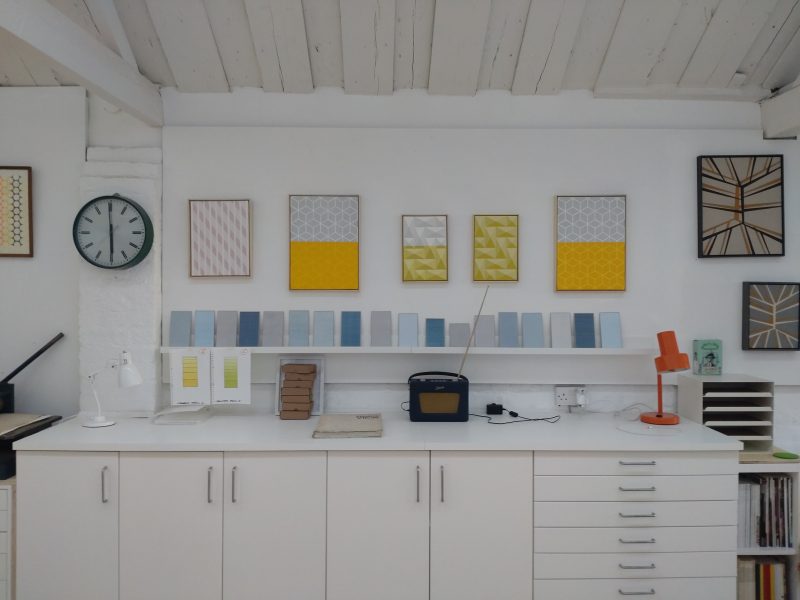
Geometry, colour and future inspirations
But Guy’s colours are bolder still than Heron’s. He talks about his interest in ‘new’ colours ―the sort of hi-vis colours, often reflective, you see on road signs and bollards. It seems perverse to translate them into a traditional medium such as oils, but this is just what’s happening here with bold, uniform and opaque layers of oil paint applied via brush and stencils to the canvas. The sharp boundaries between the geometrical painted shapes, and the spaces in between, set up a kind of vibration in the eye ― almost a visual equivalent to the pulsing minimalist soundscapes of Philip Glass and Steve Reich. We ask whether there are links, but Guy says he’s more likely to be listening to 50s and 60s jazz as he works.
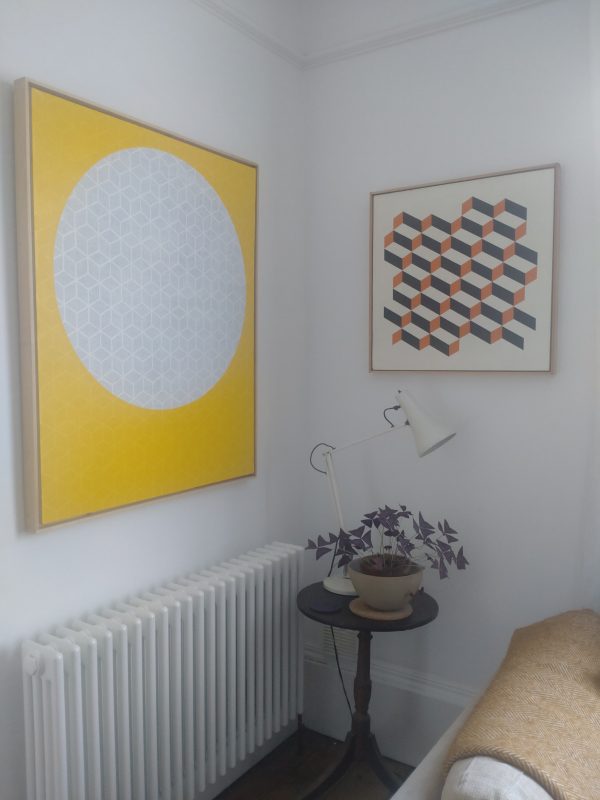
Probing a little more and asking about his inspirations, a studio drawer is opened to reveal a jumble of carefully selected roadside disjecta: reflective tape, tailgate reflectors, yellow warning light covers and so on. Such things don’t usually invite a second glance, but are actually laced with sophisticated patterns.
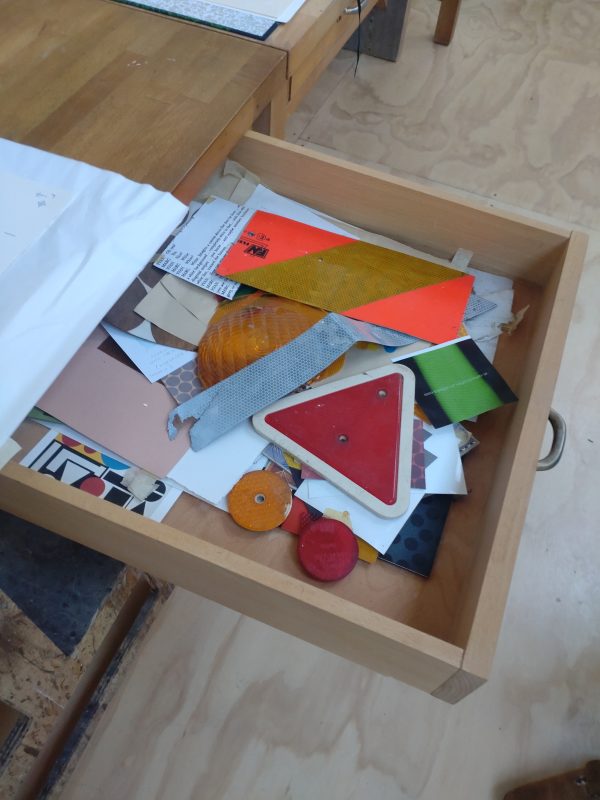
Surprising inspirations
Another drawer reveals a cache of salvaged envelopes from bills and bank statements, prized by Guy for their seemingly endless printed interior patterns designed as a security barrier against prying eyes. A series of these brilliant hidden designs has already been mounted up by Guy for contemplation, hopefully the start of a new series of paintings.
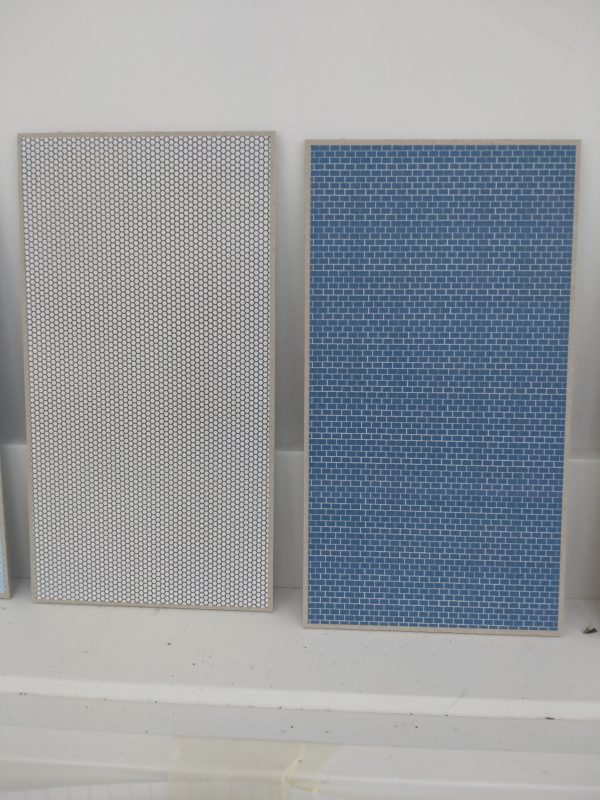
Surprising inspirations II
We talk about the reality of a contemporary artist’s life, and managing the competing demands of making a living, while remaining true to an artistic vision. Guy is uncompromising here. While some artists respond readily to demand from a buying public, or the suggestions of a gallery keen to commission saleable work, Guy follows his own path, making only the things he wants to ― though it’s obvious his pieces are both desirable and saleable. The compromise he has made is in continuing to earn a living from scene painting for film and television. From the list of recent credits he mentions (including the hit TV series Slow Horses) it’s clear he is both well-established and respected in the field.
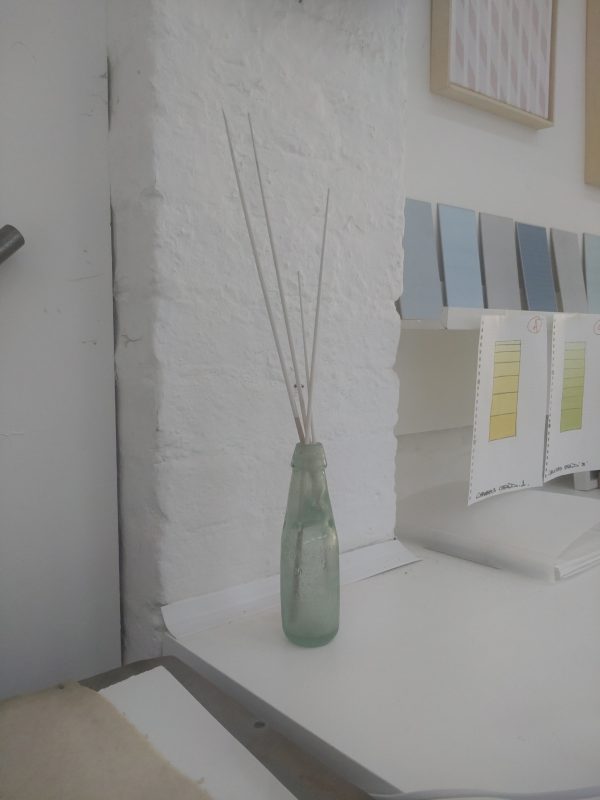
Messages in a bottle. Conductors’ batons in a Chittick’s of Faversham mineral water bottle
Time in the Faversham studio is central to Guy’s practice and continues to provide inspiration, so we ask a bit more about its origins. The building, now flanked on both sides by the terraced houses of St John’s Road, was originally the carriage barn for nearby Cooksditch House. By the late 19th century, when Cooksditch’s grounds were sold off for housing, it had become a bottling plant for the mineral water and ginger beer merchant WT Chittick. Preserved in the studio is an original Chittick’s water bottle, and it’s fascinating to speculate about where the plant’s spring was (given Faversham Life’s recent investigations into Faversham’s chalk springs). Projecting from the bottle’s mouth are now four white spines, more mementos of the studio’s former lives ― it was at one time also the workshop of a woodworker and musical instrument maker who came to specialise in making orchestral conductor’s batons. Many famous conductors sourced their batons from here in Faversham (with Simon Rattle among the maker’s clientele) and Guy found a clutch of discarded batons in a corner of the former workshop. Bottle and batons together make for a superb found object, encapsulating the former histories of what remains a wellspring of creativity in the heart of Faversham.
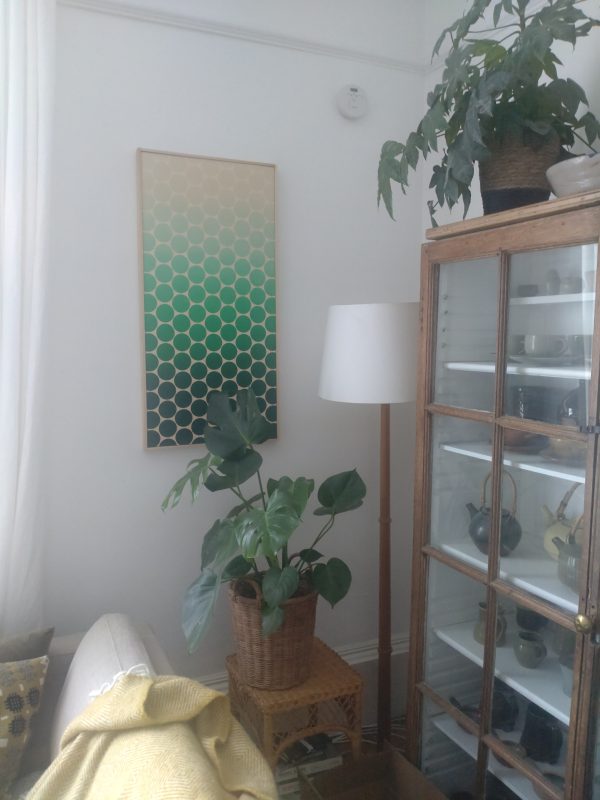
Guy Rutter can be contacted at Rutter.guy@gmail.com and you can follow his work on Instagram @guyrutterpaint Guy and Lucy Rutter will be presenting a joint exhibition of paintings, prints at ceramics at Frank, Harbour Street Whitstable from August 2024.
Text: Justin Croft. Photographs: Justin Croft